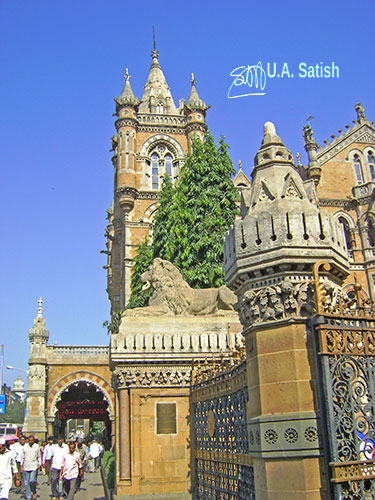Heritage buildings South Mumbai include many structures from the pre-independence era. The buildings have British and European influences. Most of the buildings are maintained well and are being used in day to day activities.

Mumbai is India’s financial capital and home to Bollywood. Bombay stock exchange, the national financial centre and large corporate offices are all gathered in South Mumbai.
Gateway of India
This is a major landmark in Mumbai. British Government built it in 1924. It is located in Apollo Bunder and overlooks Mumbai harbour. Apollo was an important pier for embarkation and disembarkation of passengers and goods in the nineteenth century. The monument commemorates the visit of King George V and Queen Mary to Mumbai. Many years later, the last of the British troops left India through this gateway. It is a popular tourist attraction in the city.

David Sassoon Library
Heritage buildings South Mumbai include David Sassoon library in the historic Kala Ghoda area which hosts many beautiful buildings including museums, art galleries and educational institutions. The library dates back to 1870. Architects J. Campbell and G. E. Gosling designed it. Above the entrance portico is a white stone bust of David Sassoon, the Merchant Prince of Bombay. Born into a prominent Jewish family in Baghdad, David S. Sassoon became one of the foremost merchants of British India and a great philanthropist. The building is a fine example of Venetian Gothic architecture. Army and Navy building is another imposing stone building which stands next to David Sassoon Library

Keneseth Eliyahoo Synagogue
Construction of the synagogue started in 1884. Bombay architects Gosling and Morris produced the design. The Sassoon family paid for it. The building has a classical revival style. The dwindling Jewish community in Mumbai preserves the synagogue.

Taj Mahal Palace
Built in 1903, Taj Mahal Palace stands opposite the Gateway of India and faces the Arabian Sea. The hotel is a gracious landmark of Mumbai. Built in the Saracenic Revival style, it opened in 1903 as the Taj Mahal Hotel and has historically often been known simply as The Taj. The hotel is named after the Taj Mahal
The hotel was targeted in the Mumbai 26/11 terror attacks in 2008. In the attack on Taj, thirty four people were killed. This included hotel guests and employees, terrorists and an army officer. Taj Mahal Palace reopened after extensive restoration on 15 August 2010.

Rajabai Tower
The Fort campus of University of Mumbai includes Rajabai Tower. It is one of the oldest educational institutes in the city, dating back to the British Bombay era. The clock tower was built in 1878 and is modelled on London’s Big Ben. The huge clock can be seen from far. Rajabai Tower has ornate figures and beautiful stained glass windows. It is named after the mother of Premchand Roychand, a stockbroker, who made liberal donations towards its construction.

Oriental Building
The heritage structure overlooks Flora Fountain in the city centre of Mumbai. The building was acquired by Oriental Life Insurance Company and re-modelled in 1898. This Heritage Building South Mumbai now houses the offices of Standard Chartered Bank.

Royal Bombay Yacht Club
The Yacht Club is located near Apollo Bunder in Mumbai. The club is the oldest yacht club in Asia, its origins stretching back to 1846. The building is a beautiful Gothic stone structure dating back to 1896. The rooms have high ceilings. The ancient elevator is in working condition. The upper floors offer splendid views of Gateway of India and Mumbai harbour.
Crawford Market – A Heritage Building South Mumbai
This is located in a bustling area of Mumbai. It is north of Chhatrapati Shivaji Terminus and opposite the headquarters of Mumbai Police. It bears the name of Arthur Crawford, the first municipal commissioner of Bombay. Completion of the building was in 1869. Sir Cowasji Jehangir financed the construction.

HSBC Building
The building on Veer Nariman Road is a heritage structure. British Bank of the Middle East was the original occupant. The neo classical building has basalt and limestone facades.

St. Thomas Cathedral
The cathedral is located on the busy Veer Nariman Road. It is midway between Horniman Circle and Flora Fountain. Construction of the church began in 1676. However consecration of the church stretched till 1718. The busy Churchgate station in the vicinity got its name from this church. The interiors of the cathedral reputedly resemble that of St. Thomas Cathedral in Belfast, Northern Ireland.
The British built the the Fort area in Bombay It had three main gates. One of the gates led straight to Saint Thomas Cathedral. Therefore it got the name of Church Gate. This authorities demolished the gate in 1860. Later the Church Gate railway station came up in 1870, close to the knocked-down gate.

Chhatrapati Shivaji Terminus
CST Terminus is the main railway station in Mumbai. It was built in 1887 and used to be known as Victoria Terminus. The ornate building commemorates the golden jubilee of the ascension to throne of England of Queen Victoria. The main building is a sandstone and limestone structure. The interiors use quality Italian marble. Stone figures of a lion and a tiger flank the main entrance to CST and represent England and India. This Heritage Building South Mumbai is a UNESCO World Heritage Site.

Central Railway organises heritage tours of Chhatrapati Shivaji Terminus. The tours take placed between 3 to 5 pm on weekdays. There is an entry fee of Rs. 200.
If you liked the post, you could…
Read more stories and get updates on my Facebook page.
Subscribe to the free and informative e-newsletter.
Related Posts
- Mumbai – The Maximum City that never sleeps
- Afghan Church in Colaba – Monument to Afghan War
- Walking Tour of South Mumbai Heritage District
